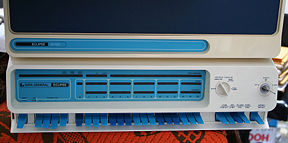
Sense switch
Encyclopedia

| Computer | Sense switches |
|---|---|
| Data General Eclipse Data General Eclipse The Data General Eclipse line of computers by Data General were 16-bit minicomputers released in early 1974 and sold until 1988. The Eclipse was based on many of the same concepts as the Data General Nova, but included support for virtual memory and multitasking more suitable to the small office... |
5 |
| IBM 7090 IBM 7090 The IBM 7090 was a second-generation transistorized version of the earlier IBM 709 vacuum tube mainframe computers and was designed for "large-scale scientific and technological applications". The 7090 was the third member of the IBM 700/7000 series scientific computers. The first 7090 installation... |
6 |
| IBM 1620 IBM 1620 The IBM 1620 was announced by IBM on October 21, 1959, and marketed as an inexpensive "scientific computer". After a total production of about two thousand machines, it was withdrawn on November 19, 1970... |
4 |
| PDP-1 PDP-1 The PDP-1 was the first computer in Digital Equipment Corporation's PDP series and was first produced in 1960. It is famous for being the computer most important in the creation of hacker culture at MIT, BBN and elsewhere... |
6 |
On the IBM 1620
IBM 1620
The IBM 1620 was announced by IBM on October 21, 1959, and marketed as an inexpensive "scientific computer". After a total production of about two thousand machines, it was withdrawn on November 19, 1970...
there were four switches, and their state could be tested via special forms of the IF-statement offered by the FORTRAN
Fortran
Fortran is a general-purpose, procedural, imperative programming language that is especially suited to numeric computation and scientific computing...
compiler for the IBM 1620. For the IBM 1130
IBM 1130
The IBM 1130 Computing System was introduced in 1965. It was IBM's least-expensive computer to date, and was aimed at price-sensitive, computing-intensive technical markets like education and engineering. It succeeded the IBM 1620 in that market segment. The IBM 1800 was a process control variant...
there were sixteen switches matching the sixteen-bit word size of the computer, plus a toggle switch adjacent to the power on/off switch. These bit-switches were more normally used with the computer stopped to specify some memory address to be viewed (via the indicator lights on the console), or set. The state of these switches could be determined by a program, and so a running programme might modify its behaviour depending on the switches, such as change the amount of progress information printed, alter the tactics of a multi-variable optimisation attempt, and so on. The IBM 1130 also had an "Interrupt Request" key associated with the console printer, whose pressing might cause a suitably programmed long-running programme to type a progress report on the console printer. In the more usual batch job environment, it was pressed by the computer operator to signal the operating system to terminate a running programme that had perhaps overrun its allowed time, or commenced misbehaviour such as repeatedly printing blank lines.
The front panel of the Data General Eclipse
Data General Eclipse
The Data General Eclipse line of computers by Data General were 16-bit minicomputers released in early 1974 and sold until 1988. The Eclipse was based on many of the same concepts as the Data General Nova, but included support for virtual memory and multitasking more suitable to the small office...
computer had 5 sense switches, 16 address switches, and 5 control switches, as shown (left to right) in the figure at right.
Personal computers replace the function of fixed sense switches with the keyboard and screen user interface.
A typical running application has two modes: either it has nothing to do and awaits some user action, or, some action is in progress that will take a long time to complete. If a program did not regularly test the state of sense switches during a long calculation, they would be ineffective at changing the program's operation.

